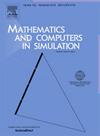Multi-material topology optimization using isogeometric method based reaction–diffusion level set techniques
IF 4.4
2区 数学
Q1 COMPUTER SCIENCE, INTERDISCIPLINARY APPLICATIONS
引用次数: 0
Abstract
This work presents a new approach to multi-material topology optimization (MMTO) using Isogeometric Analysis (IGA) based reaction–diffusion equation (RDE) level set method. Level set based topology optimization, frequently used for achieving clear material boundaries and avoiding checkerboard patterns in topology optimization problems is further augmented by RDEs which enhance numerical stability of the solver. The multi-material formulation uses a blended combination of different level-set functions to ensure that each point in the domain corresponds to a single material. In this work, isogeometric analysis (IGA) is used for the first time in RDE-based level set for solving MMTO problems. The same Non-Uniform Rational B-Splines (NURBS) basis function is used for approximating state variables, geometry modeling and level set function, thus facilitating seamless coupling between analysis and product design. Using the IGAFEM toolbox (Nguyen et al., 2015), MMTO is performed for a few benchmark problems for varying material composition and mesh sizes. Results indicate that satisfactory distribution of material is achieved in all the MMTO examples and bi-quadratic element based IGA is a competent tool to be applied in RDE-based level set method for topology optimization. Future work will focus on using the same IGA framework for further shape optimization of the designed structures to produce fabrication ready CAD models.
基于反应扩散水平集技术的等几何方法的多材料拓扑优化
本文提出了一种基于等几何分析(IGA)的反应扩散方程(RDE)水平集方法的多材料拓扑优化(MMTO)新方法。基于水平集的拓扑优化通常用于实现清晰的材料边界和避免拓扑优化问题中的棋盘格模式,而rde进一步增强了基于水平集的拓扑优化,提高了求解器的数值稳定性。多材料配方使用不同水平集函数的混合组合,以确保域中的每个点对应于单个材料。本文首次将等几何分析(IGA)用于基于rde的水平集求解MMTO问题。使用相同的非均匀有理b样条(NURBS)基函数逼近状态变量、几何建模和水平集函数,从而促进分析与产品设计之间的无缝耦合。使用IGAFEM工具箱(Nguyen et al., 2015),对不同材料组成和网格尺寸的一些基准问题执行MMTO。结果表明,基于双二次元的遗传算法可以很好地应用于基于rde的水平集拓扑优化中。未来的工作将集中在使用相同的IGA框架对设计结构进行进一步的形状优化,以产生制造就绪的CAD模型。
本文章由计算机程序翻译,如有差异,请以英文原文为准。
求助全文
约1分钟内获得全文
求助全文
来源期刊

Mathematics and Computers in Simulation
数学-计算机:跨学科应用
CiteScore
8.90
自引率
4.30%
发文量
335
审稿时长
54 days
期刊介绍:
The aim of the journal is to provide an international forum for the dissemination of up-to-date information in the fields of the mathematics and computers, in particular (but not exclusively) as they apply to the dynamics of systems, their simulation and scientific computation in general. Published material ranges from short, concise research papers to more general tutorial articles.
Mathematics and Computers in Simulation, published monthly, is the official organ of IMACS, the International Association for Mathematics and Computers in Simulation (Formerly AICA). This Association, founded in 1955 and legally incorporated in 1956 is a member of FIACC (the Five International Associations Coordinating Committee), together with IFIP, IFAV, IFORS and IMEKO.
Topics covered by the journal include mathematical tools in:
•The foundations of systems modelling
•Numerical analysis and the development of algorithms for simulation
They also include considerations about computer hardware for simulation and about special software and compilers.
The journal also publishes articles concerned with specific applications of modelling and simulation in science and engineering, with relevant applied mathematics, the general philosophy of systems simulation, and their impact on disciplinary and interdisciplinary research.
The journal includes a Book Review section -- and a "News on IMACS" section that contains a Calendar of future Conferences/Events and other information about the Association.
 求助内容:
求助内容: 应助结果提醒方式:
应助结果提醒方式:


